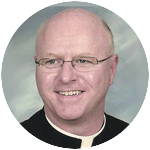
Msgr. Joseph Prior
(See the readings for the 15th Sunday in Ordinary Time, July 14)
One of the ancient Christian art forms is the icon. The practice developed early in the eastern church and has a long tradition associated with it. The image portrayed in the icon is meant to represent the divine or some aspect of God or his church.
The “writer” (the term used for the person painting the icon) spends much time in prayer and contemplation before beginning and then during the work. In this mindset God is the real author; the writer is trying to portrays an image that will lead the viewer closer to the reality represented.
The term “icon” (not to be confused with the contemporary use associated with computer applications) has its origin in the Greek language as a word for “image” or “likeness.” The term is sometimes used for the Christian who is called to represent in their lives the God whom they love and serve. This meaning comes to mind today when we reflect on the readings for Sunday’s liturgy.
[hotblock]
The Gospel passage recalls the time when Jesus was asked by a young lawyer what he must do to inherit eternal life. When Jesus replies with the question, “What is written in the law?” the young man replies: “You shall love the Lord, your God, with all your heart, with all your being, with all your strength, and with all your mind, and your neighbor as yourself.” Jesus affirms the answer.
The scholar, “seeking to justify himself,” asks a further question: “And who is my neighbor?” Jesus replies with the story of the Good Samaritan. At the end of the story he asks the man: “Which of these three, in your opinion, was neighbor to the robbers’ victim?” The young man answers: “The one who treated him with mercy.” Jesus’ final words in the dialogue are: “Go and do likewise.”
The two-fold love of God and neighbor is wonderfully illustrated in the dialogue. Jesus does not dismiss the man because he is “seeking to justify himself” but leads him into a deeper understanding of God’s love. Jesus himself is the icon of this love, even in this simple interaction.
The Colossians’ hymn (second reading) reminds us that Jesus is the icon of the Father — he represents the unseen Father to the world. He is “the image of the invisible God, the firstborn of all creation. For in him were created all things in heaven and earth, the visible and invisible…. He is before all things, and in him all things hold together. He is the head of the body, the church. He is the beginning, the firstborn from the dead…. For in him all the fullness was pleased to dwell, and through him to reconcile all things for him, making peace through the blood of his cross.”
[tower]
The love of God and love of neighbor are perfectly realized and visible in Jesus. He ties the two parts of the law into one. Love of God and love of neighbor are both essential. The instruction Jesus gives at the end of the dialogue with the young lawyer invites him and all of us who follow the Lord to become icons of this law, the law of love. If we consider our union with Christ in baptism we also are called to be an icon of his love.
The first reading reminds us that this law of love is not distant from us nor remote for it is written in our hearts (created as we are in the image and likeness of God). The last word of the passage give us an insight into accessing this law of love. The author writes: “No, it is very near to you, already in your mouths and hearts; you have only to carry it out.” In other words, when we live the law of love we will know the love that is always there and always present.
The Gospel and the Deuteronomy reading both end with an instruction to act, to live the law of mercy and love. We do this every day with family and friends. Jesus, however, is asking us to go well beyond those groups.
The Samaritan in the story was a foreigner, a Gentile, a non-Jew. There was a great animosity between the Jews and Samaritans. The young lawyer was a Jew. When he hears and acknowledges that the Samaritan was the one who understood the law at its core, he naturally would have to re-think any of the attitudes or conceptions he inherits from his culture. The same would be true of the purity laws associated with blood which may have influenced the priest and Levite in their decision not to act.
Jesus leads the young scholar deeper into the mystery of divine love in this interaction. He invites us to go deeper into this reality as well.
C.K. Chesterton once humorously wrote: “We make our friends, we make our enemies, but God makes our next door neighbor … and we have to love our neighbor because he is there.” Our neighbor is anyone whom we encounter. If we think of this in terms of God’s providence then they are there for a reason. Part of that reason is that they may encounter the love of God through the love of neighbor.
In these interactions we become the “icon” of God. We represent his love and in loving that neighbor we love him who put that neighbor there.
***
Msgr. Joseph Prior is pastor of Our Lady of Grace Parish, Penndel, and a former professor of Sacred Scripture and rector of St. Charles Borromeo Seminary.
PREVIOUS: Flowers, signs and distractions near a monstrance
NEXT: Readings of the Holy Mass – Fifteenth Sunday in Ordinary Time



Share this story